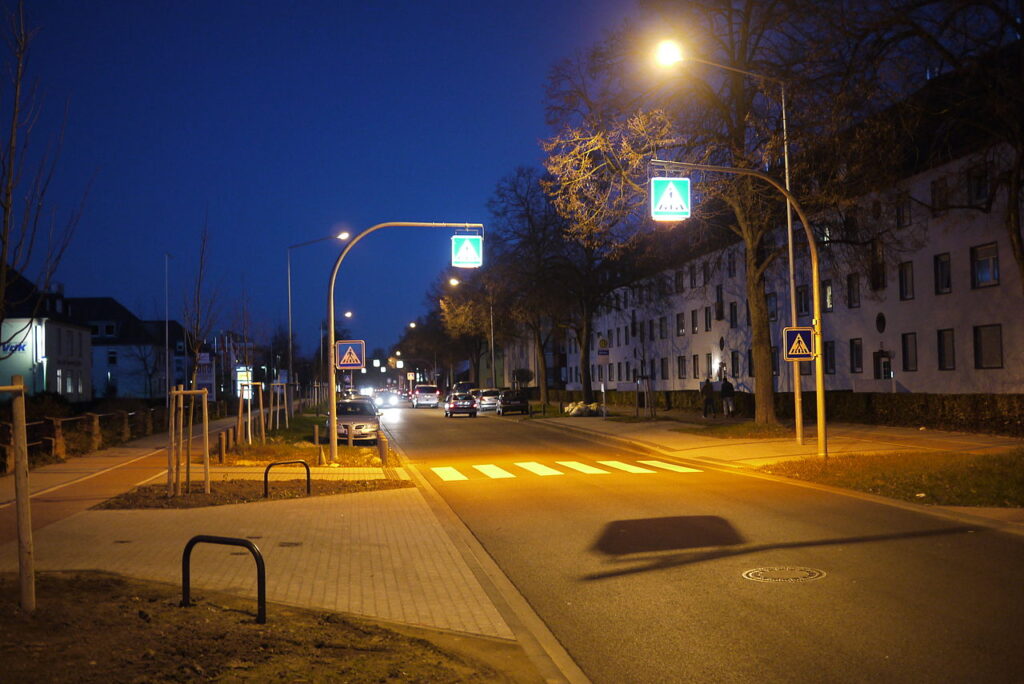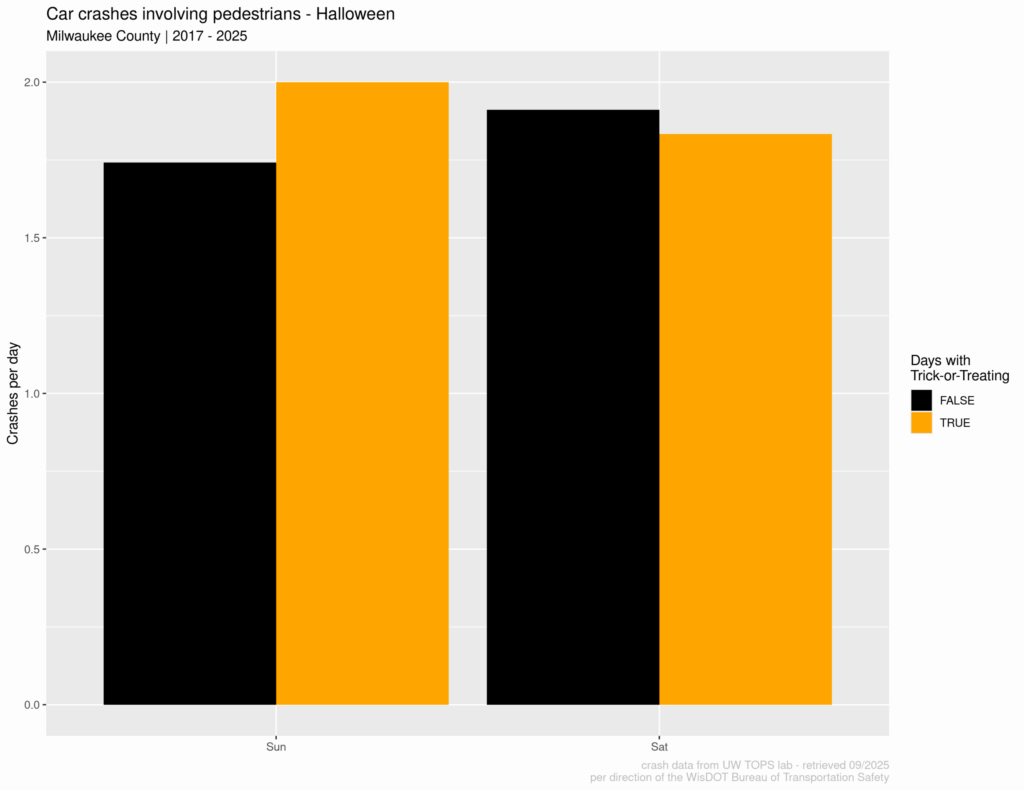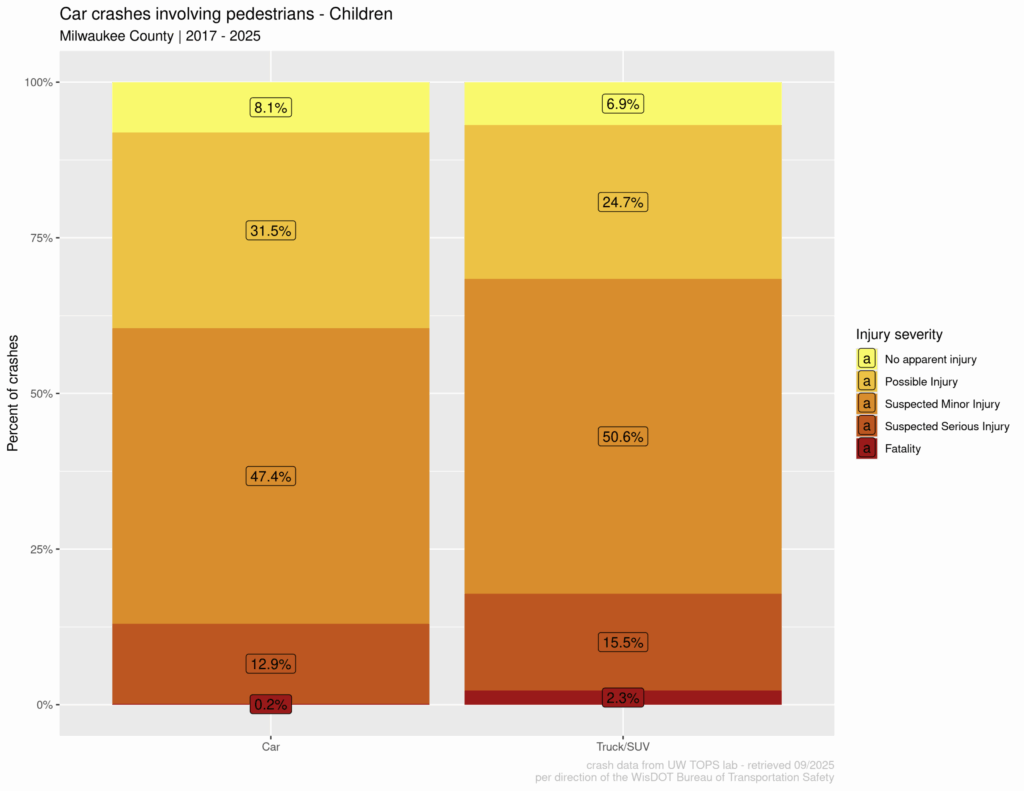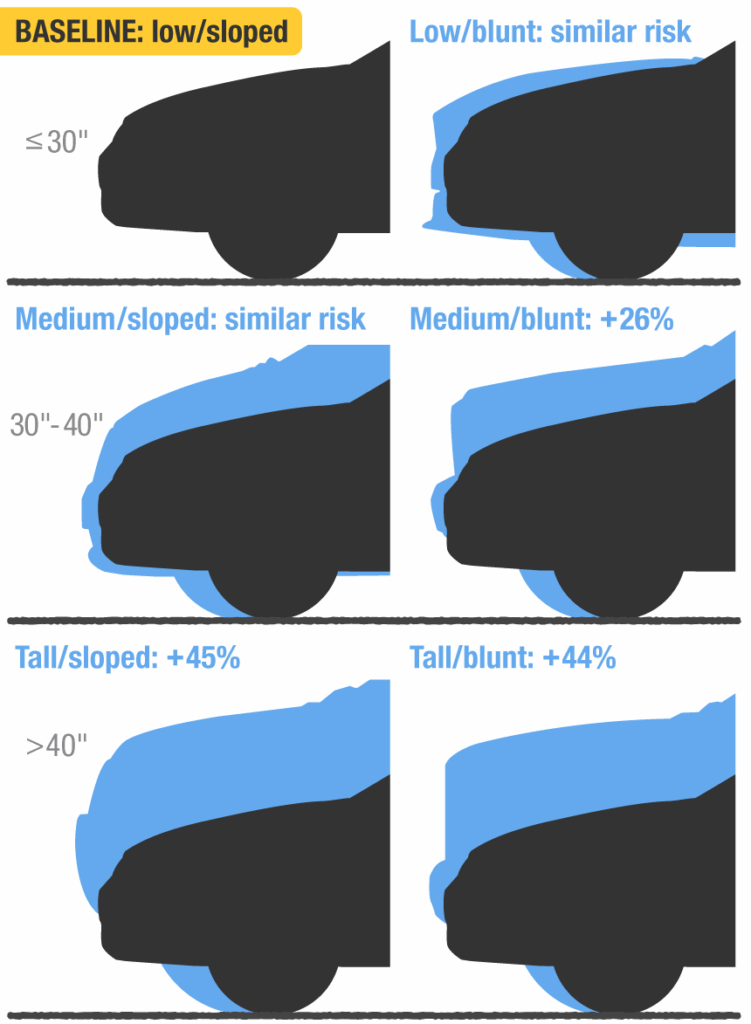This continues our series of blog posts for Pedestrian Safety Month. In this post, we’re looking at patterns of pedestrian-involved crashes: what do we notice about the impact of daylight, school starting, Halloween, and vehicle sizes on pedestrian safety
In our first blog post, we looked at a big picture of trends in pedestrian safety, in our second blog post we looked at how different parts of the city and specific street designs impact safety. This third post is going to be looking at other patterns we’ve noticed about pedestrian-involved crashes:
- What is the seasonality of pedestrian-involved crashes?
- How dangerous is Halloween for pedestrians in Milwaukee?
- How have changing vehicle sizes changed risks to people walking?
Seasonality of pedestrian-involved crashes
We see changes throughout the year in how many people are hit by cars while walking:

This graph is showing two things:
- the average monthly pedestrian-involved crashes from 2017-2024, split by adult and children
- the pedestrian involved crashes so far in 2025, again split by adult and children
Children are more likely to be hit during the overlap of nice weather and the school year. Adults are more likely to be hit during the fall and start of winter.
Here are weekly averages for adult pedestrians hit in the City of Milwaukee:

There’s a pretty big spike the first week of October. The city’s Pedestrian Plan explains the increase as “October still has relatively nice weather, but most schools are in session and there are fewer hours of daylight than summer months.” The plan also highlights the role that alcohol plays in crashes and the start of October also coincides with a number of festivals in the city, including Oktoberfest.
One reason why pedestrians are more likely to be hit in the fall and winter is it’s darker when people are walking. Some people want to blame pedestrians by saying that they should wear hi-vis clothing, but a systems solution would be to strategically increase lighting and make crosswalks more visible. Smart Growth America, a national non-profit focused on livable cities, writes that “brighter streets are safer streets, resulting in reduced pedestrian fatalities and crashes, increased usability for people with vision impairments, and improved perceived comfort for pedestrians. People who walk deserve access to safe walkways any time of the day or night.”

Improved pedestrian lighting example. Image: Detas Group
Milwaukee is starting to do that. The city is improving lighting in 68 locations that are particularly dangerous for pedestrians and upgrading existing lighting to modern LED bulbs with more reliable circuits. This project is ongoing and expected to be complete by the end of 2026. It will end up upgrading over 60% of the city’s street lights.
Halloween
Nationally, Halloween is notorious for being one of the most dangerous days for pedestrians, particularly kids. According to a study of 4 decades of Halloween and pedestrian deaths, Halloween is riskier for people walking because “celebrations occur at dusk, masks restrict peripheral vision, costumes limit visibility, street-crossing safety is neglected, and some partygoers are impaired by alcohol.” Additionally, there’s just a lot more people walking while trick-or-treating than other nights.
Looking at Milwaukee County however, that doesn’t seem to be the case in the last 8 years:

This shows just Saturdays and Sundays and compares the average pedestrian-involved crashes for those days that are trick-or-treating days compared to all other Saturday or Sundays throughout the year. No big discrepancy.
Perhaps Milwaukee has fewer pedestrian crashes on Halloween because fewer kids are actually out trick-or-treating throughout neighborhoods. Some families have the impulse to move towards “trunk-or-treat” type events to keep kids off the streets, but those events just bypass the issue of safe streets.
That study of pedestrian risks on Halloween concluded that “Halloween trick-or-treating encourages creativity, physical activity, and neighborhood engagement. Trick-or-treating should not be abolished in a misguided effort to eliminate Halloween-associated risk. Instead, policymakers, physicians, and parents should act to make residential streets safer for pedestrians on Halloween and throughout the year.”
That’s exactly what some neighborhoods in Milwaukee are doing!
The Washington Heights neighborhood has organized an annual “Spooktacular” event every year for over 30 years where the neighborhood closes off a portion of the neighborhood to car traffic, recruits volunteer crossing guards for other parts of the neighborhood and sanctions nighttime trick-or-treating for kids and families. It’s rare to see an organized nighttime trick-or-treating event these days.
Vehicle Sizes
In recent years, vehicle sizes have been increasing and bigger vehicle types (SUVs and trucks) are becoming more popular in the US. This has unfortunate impacts for pedestrian safety.
Here’s a graph of the injury severity of children hit by different types of vehicles in Milwaukee County:

While just 0.2% of cars hitting pedestrians killed the pedestrian, 2.3% of Trucks and SUVs that hit pedestrians killed the pedestrian. 2.3% might not seem like a lot, but that’s a 10x increase in fatality rates compared with cars!
The Insurance Institute for Highway Safety (IIHS) has found that “Over the past 30 years, the average U.S. passenger vehicle has gotten about 4 inches wider, 10 inches longer, 8 inches taller and 1,000 pounds heavier. Many vehicles are more than 40 inches tall at the leading edge of the hood. On some large pickups, the hoods are almost at eye level for many adults … Vehicles with hoods more than 40 inches off the ground at the leading edge and a grille sloped at an angle of 65 degrees or less were 45 percent more likely to cause pedestrian fatalities than those with a similar slope and hood heights of 30 inches or less.”

Credit: IIHS
In addition to increasing the severity of injury in the case of a car crash, bigger vehicles are more likely to crash into pedestrians because they have longer stopping distances and bigger blind spots.
There are a variety of reasons why someone might need a bigger vehicle, but drivers need to understand the level of risk associated with their vehicles and drive with that risk in mind. Furthermore, as larger vehicles cause damage to pavement at an exponentially higher rate than smaller vehicles, there’s a financial case to incentivize smaller vehicles. Paris has implemented parking rates that charge drivers of SUVs 3x more to park than sedans.
In 2024, the National Highway Traffic Safety Administration proposed new regulation for vehicles that would test for the safety of pedestrians for the first time in their safety ratings. This week, those rules were delayed by another 2 years.
How to learn more?
Learn more about MilWALKee Walks, the Bike Fed’s pedestrian Safety program here! Learn more about the work we do and get involved with some of our events.
Click here to read a summary of Milwaukee County’s 2024 pedestrian fatalities. You can also explore our interactive map, showing where pedestrians and bicyclists have been involved in motor vehicle crashes.
If you’re interested in how these figures were created, you can see the code that generated them here.
This blog was also published on the WI Bike Fed blog, as part of Pedestrian Safety Month.
